Abstract
OBJECTIVES--A method based on a nested polymerase chain reaction (PCR) was developed to detect and to type Chlamydia trachomatis from low titre samples by amplifying a large portion of the major outer membrane protein gene. The sensitivity of this procedure was evaluated in urogenital clinical samples in comparison with culture. SPECIMENS--A series of 787 urogenital specimens, including 37 (4.7%) positive by culture, together with 227 other samples that had been found to yield less than 25 chlamydial inclusions in culture were tested. METHODS--Samples were pelleted, resuspended in 1 mM NaOH, heated and amplified without further purification. After 40 cycles of PCR, 1 microliters of product was amplified by a further 30 cycles of PCR using a second set of primers nested within the initial pair. Positives were detected by agarose gel electrophoresis and confirmed by repeating the PCR analyses and determining the serovar of both amplified samples by restriction fragment length polymorphism. RESULTS--Nested PCR allowed detection of 96% and culture 77% of positives with only three samples repeatedly positive by PCR but considered false positives because a different serovar was identified in the two amplifications. Of culture-positive samples with less than 11 chlamydia inclusion-forming-units 97% could be detected by nested PCR and most still gave a positive signal when diluted hundred fold. CONCLUSIONS--Nested PCR provided the basis for a very sensitive C trachomatis detection and typing strategy. Repetition and typing positive samples facilitated detection of false-positive PCR specimens resulting from contamination of the PCR process or any reagent except the original sample.
Full text
PDF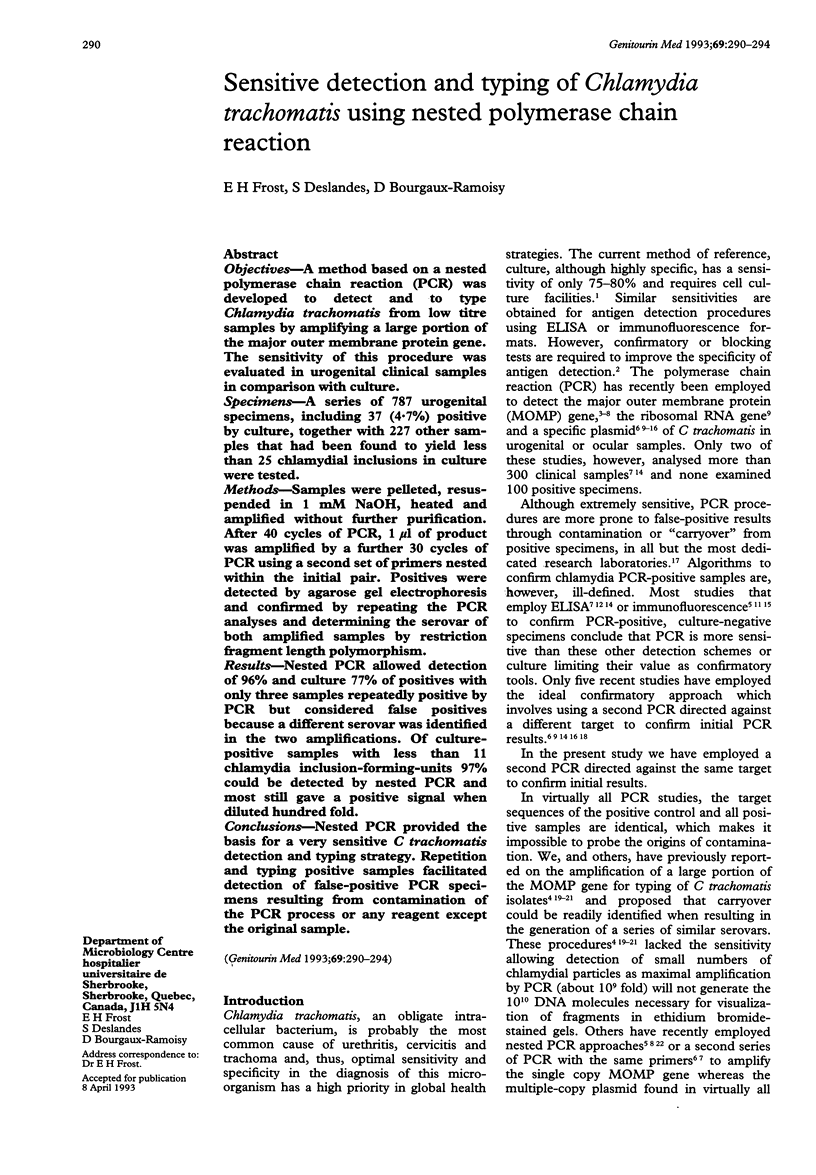
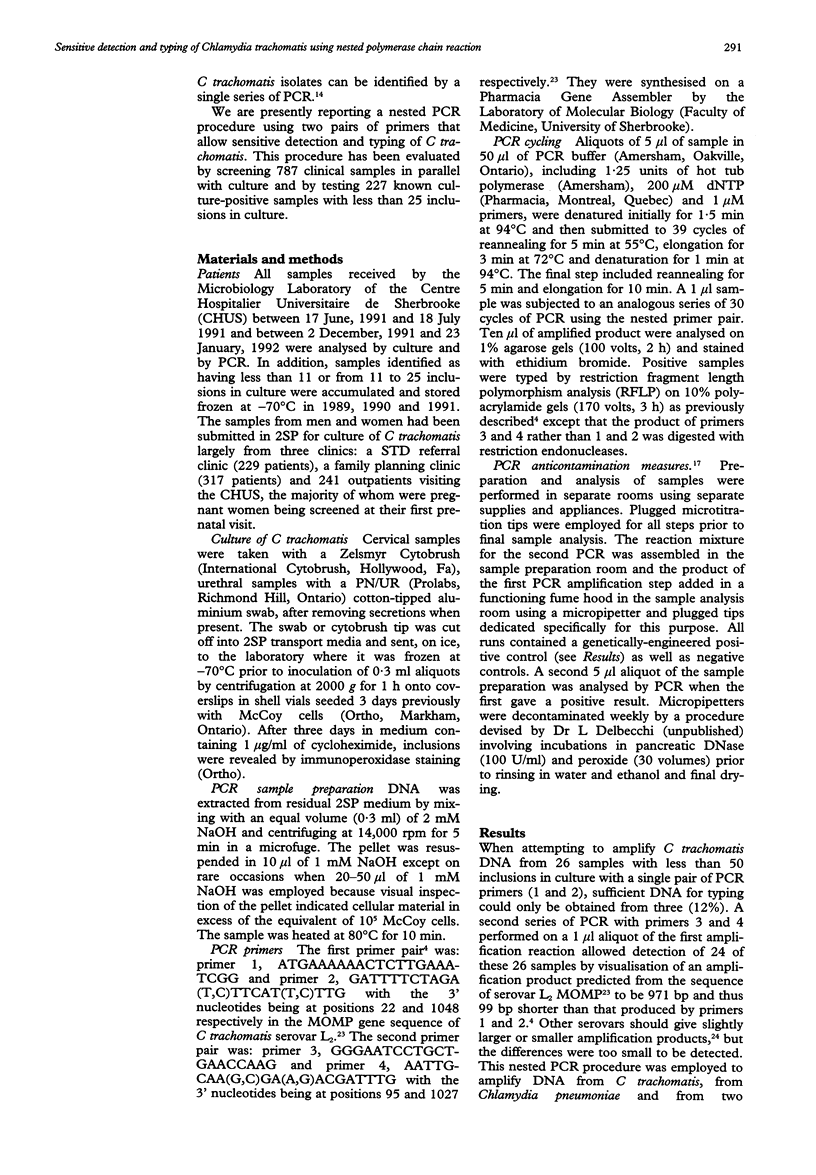
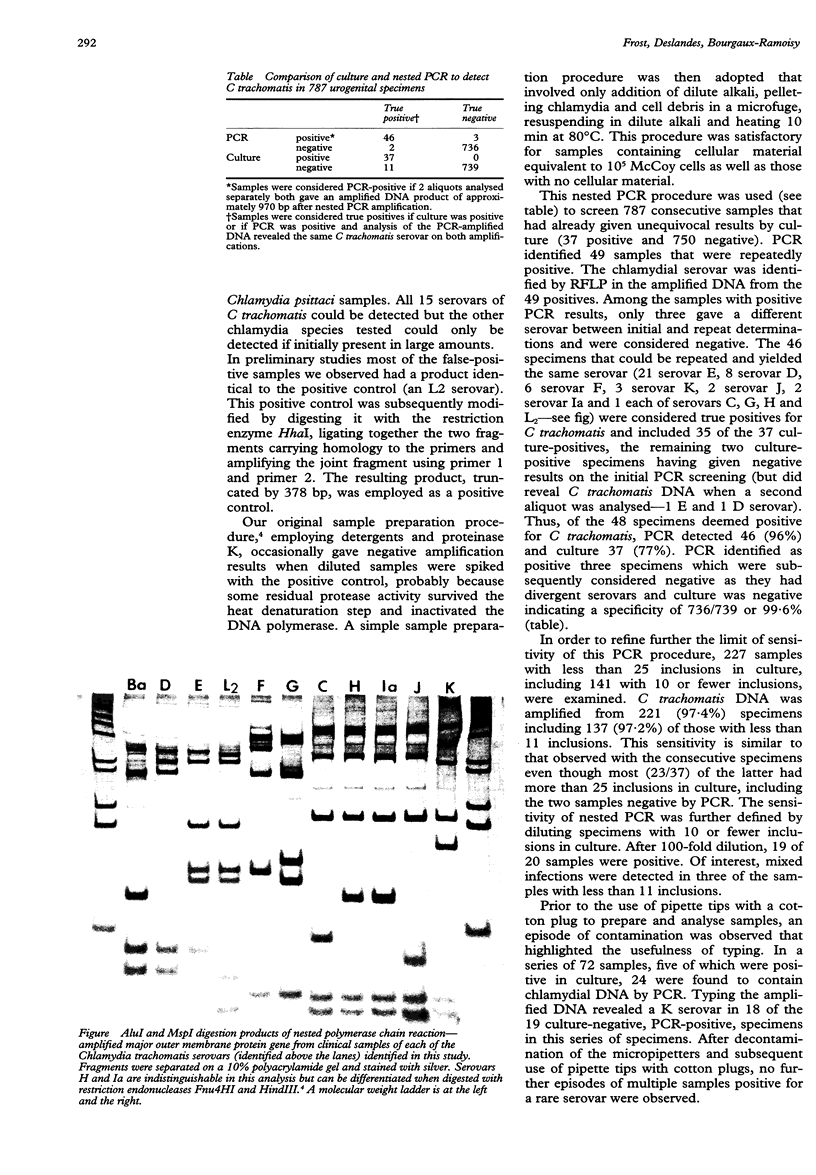
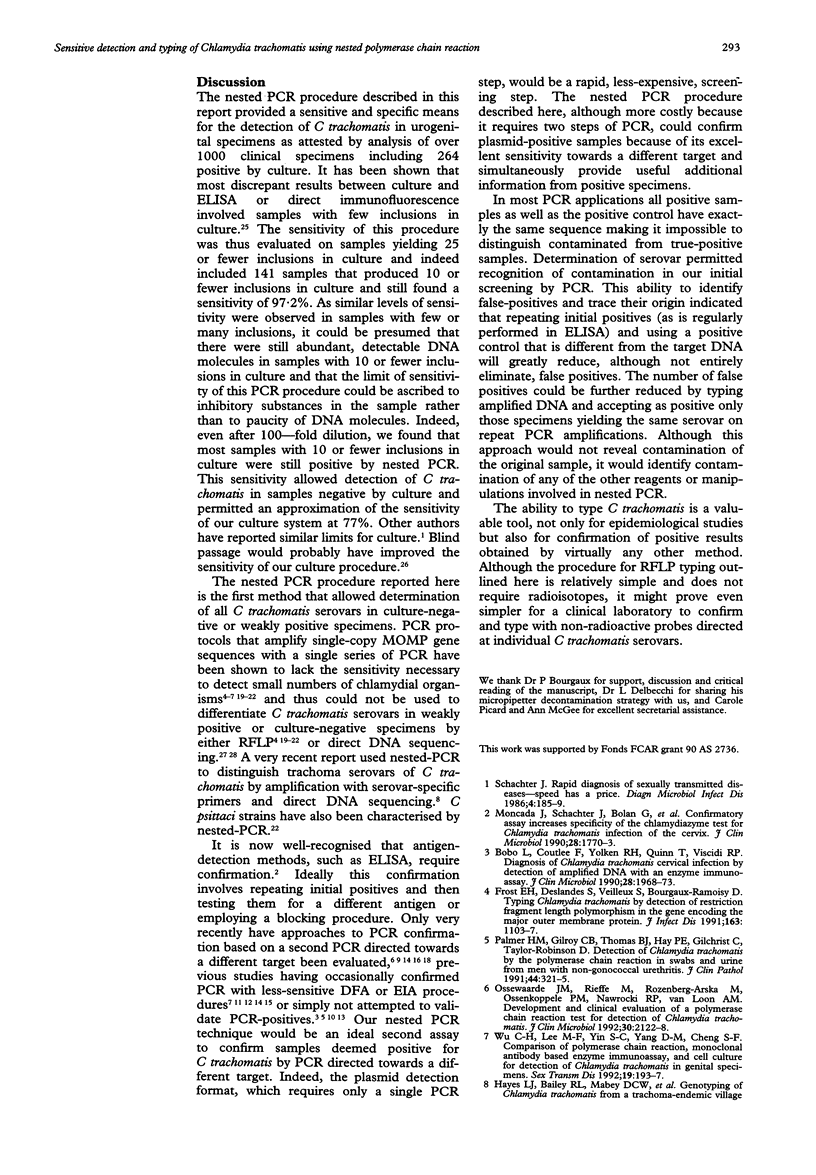
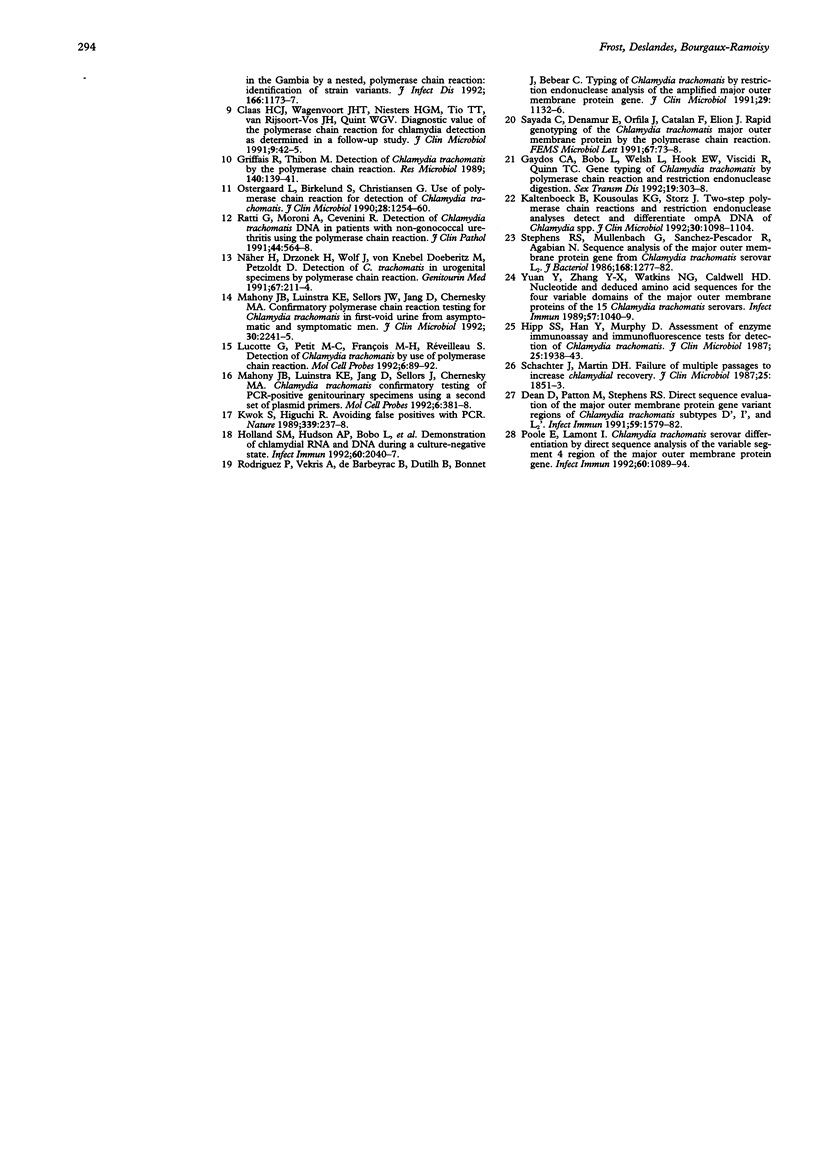
Images in this article
Selected References
These references are in PubMed. This may not be the complete list of references from this article.
- Bobo L., Coutlee F., Yolken R. H., Quinn T., Viscidi R. P. Diagnosis of Chlamydia trachomatis cervical infection by detection of amplified DNA with an enzyme immunoassay. J Clin Microbiol. 1990 Sep;28(9):1968–1973. doi: 10.1128/jcm.28.9.1968-1973.1990. [DOI] [PMC free article] [PubMed] [Google Scholar]
- Claas H. C., Wagenvoort J. H., Niesters H. G., Tio T. T., Van Rijsoort-Vos J. H., Quint W. G. Diagnostic value of the polymerase chain reaction for Chlamydia detection as determined in a follow-up study. J Clin Microbiol. 1991 Jan;29(1):42–45. doi: 10.1128/jcm.29.1.42-45.1991. [DOI] [PMC free article] [PubMed] [Google Scholar]
- Dean D., Patton M., Stephens R. S. Direct sequence evaluation of the major outer membrane protein gene variant regions of Chlamydia trachomatis subtypes D', I', and L2'. Infect Immun. 1991 Apr;59(4):1579–1582. doi: 10.1128/iai.59.4.1579-1582.1991. [DOI] [PMC free article] [PubMed] [Google Scholar]
- Frost E. H., Deslandes S., Veilleux S., Bourgaux-Ramoisy D. Typing Chlamydia trachomatis by detection of restriction fragment length polymorphism in the gene encoding the major outer membrane protein. J Infect Dis. 1991 May;163(5):1103–1107. doi: 10.1093/infdis/163.5.1103. [DOI] [PubMed] [Google Scholar]
- Gaydos C. A., Bobo L., Welsh L., Hook E. W., 3rd, Viscidi R., Quinn T. C. Gene typing of Chlamydia trachomatis by polymerase chain reaction and restriction endonuclease digestion. Sex Transm Dis. 1992 Nov-Dec;19(6):303–308. [PubMed] [Google Scholar]
- Griffais R., Thibon M. Detection of Chlamydia trachomatis by the polymerase chain reaction. Res Microbiol. 1989 Feb;140(2):139–141. doi: 10.1016/0923-2508(89)90047-8. [DOI] [PubMed] [Google Scholar]
- Hayes L. J., Bailey R. L., Mabey D. C., Clarke I. N., Pickett M. A., Watt P. J., Ward M. E. Genotyping of Chlamydia trachomatis from a trachoma-endemic village in the Gambia by a nested polymerase chain reaction: identification of strain variants. J Infect Dis. 1992 Nov;166(5):1173–1177. doi: 10.1093/infdis/166.5.1173. [DOI] [PubMed] [Google Scholar]
- Hipp S. S., Han Y., Murphy D. Assessment of enzyme immunoassay and immunofluorescence tests for detection of Chlamydia trachomatis. J Clin Microbiol. 1987 Oct;25(10):1938–1943. doi: 10.1128/jcm.25.10.1938-1943.1987. [DOI] [PMC free article] [PubMed] [Google Scholar]
- Holland S. M., Hudson A. P., Bobo L., Whittum-Hudson J. A., Viscidi R. P., Quinn T. C., Taylor H. R. Demonstration of chlamydial RNA and DNA during a culture-negative state. Infect Immun. 1992 May;60(5):2040–2047. doi: 10.1128/iai.60.5.2040-2047.1992. [DOI] [PMC free article] [PubMed] [Google Scholar]
- Kaltenboeck B., Kousoulas K. G., Storz J. Two-step polymerase chain reactions and restriction endonuclease analyses detect and differentiate ompA DNA of Chlamydia spp. J Clin Microbiol. 1992 May;30(5):1098–1104. doi: 10.1128/jcm.30.5.1098-1104.1992. [DOI] [PMC free article] [PubMed] [Google Scholar]
- Kwok S., Higuchi R. Avoiding false positives with PCR. Nature. 1989 May 18;339(6221):237–238. doi: 10.1038/339237a0. [DOI] [PubMed] [Google Scholar]
- Lucotte G., Petit M. C., François M. H., Réveilleau S. Detection of Chlamydia trachomatis by use of polymerase chain reaction. Mol Cell Probes. 1992 Apr;6(2):89–92. doi: 10.1016/0890-8508(92)90051-x. [DOI] [PubMed] [Google Scholar]
- Mahony J. B., Luinstra K. E., Jang D., Sellors J., Chernesky M. A. Chlamydia trachomatis confirmatory testing of PCR-positive genitourinary specimens using a second set of plasmid primers. Mol Cell Probes. 1992 Oct;6(5):381–388. doi: 10.1016/0890-8508(92)90031-r. [DOI] [PubMed] [Google Scholar]
- Mahony J. B., Luinstra K. E., Sellors J. W., Jang D., Chernesky M. A. Confirmatory polymerase chain reaction testing for Chlamydia trachomatis in first-void urine from asymptomatic and symptomatic men. J Clin Microbiol. 1992 Sep;30(9):2241–2245. doi: 10.1128/jcm.30.9.2241-2245.1992. [DOI] [PMC free article] [PubMed] [Google Scholar]
- Moncada J., Schachter J., Bolan G., Engelman J., Howard L., Mushahwar I., Ridgway G., Mumtaz G., Stamm W., Clark A. Confirmatory assay increases specificity of the chlamydiazyme test for Chlamydia trachomatis infection of the cervix. J Clin Microbiol. 1990 Aug;28(8):1770–1773. doi: 10.1128/jcm.28.8.1770-1773.1990. [DOI] [PMC free article] [PubMed] [Google Scholar]
- Näher H., Drzonek H., Wolf J., von Knebel Doeberitz M., Petzoldt D. Detection of C trachomatis in urogenital specimens by polymerase chain reaction. Genitourin Med. 1991 Jun;67(3):211–214. doi: 10.1136/sti.67.3.211. [DOI] [PMC free article] [PubMed] [Google Scholar]
- Ossewaarde J. M., Rieffe M., Rozenberg-Arska M., Ossenkoppele P. M., Nawrocki R. P., van Loon A. M. Development and clinical evaluation of a polymerase chain reaction test for detection of Chlamydia trachomatis. J Clin Microbiol. 1992 Aug;30(8):2122–2128. doi: 10.1128/jcm.30.8.2122-2128.1992. [DOI] [PMC free article] [PubMed] [Google Scholar]
- Ostergaard L., Birkelund S., Christiansen G. Use of polymerase chain reaction for detection of Chlamydia trachomatis. J Clin Microbiol. 1990 Jun;28(6):1254–1260. doi: 10.1128/jcm.28.6.1254-1260.1990. [DOI] [PMC free article] [PubMed] [Google Scholar]
- Palmer H. M., Gilroy C. B., Thomas B. J., Hay P. E., Gilchrist C., Taylor-Robinson D. Detection of Chlamydia trachomatis by the polymerase chain reaction in swabs and urine from men with non-gonococcal urethritis. J Clin Pathol. 1991 Apr;44(4):321–325. doi: 10.1136/jcp.44.4.321. [DOI] [PMC free article] [PubMed] [Google Scholar]
- Poole E., Lamont I. Chlamydia trachomatis serovar differentiation by direct sequence analysis of the variable segment 4 region of the major outer membrane protein gene. Infect Immun. 1992 Mar;60(3):1089–1094. doi: 10.1128/iai.60.3.1089-1094.1992. [DOI] [PMC free article] [PubMed] [Google Scholar]
- Rodriguez P., Vekris A., de Barbeyrac B., Dutilh B., Bonnet J., Bebear C. Typing of Chlamydia trachomatis by restriction endonuclease analysis of the amplified major outer membrane protein gene. J Clin Microbiol. 1991 Jun;29(6):1132–1136. doi: 10.1128/jcm.29.6.1132-1136.1991. [DOI] [PMC free article] [PubMed] [Google Scholar]
- Schachter J., Martin D. H. Failure of multiple passages to increase chlamydial recovery. J Clin Microbiol. 1987 Oct;25(10):1851–1853. doi: 10.1128/jcm.25.10.1851-1853.1987. [DOI] [PMC free article] [PubMed] [Google Scholar]
- Schachter J. Rapid diagnosis of sexually transmitted diseases--speed has a price. Diagn Microbiol Infect Dis. 1986 Mar;4(3):185–189. doi: 10.1016/0732-8893(86)90097-0. [DOI] [PubMed] [Google Scholar]
- Stephens R. S., Mullenbach G., Sanchez-Pescador R., Agabian N. Sequence analysis of the major outer membrane protein gene from Chlamydia trachomatis serovar L2. J Bacteriol. 1986 Dec;168(3):1277–1282. doi: 10.1128/jb.168.3.1277-1282.1986. [DOI] [PMC free article] [PubMed] [Google Scholar]
- Wu C. H., Lee M. F., Yin S. C., Yang D. M., Cheng S. F. Comparison of polymerase chain reaction, monoclonal antibody based enzyme immunoassay, and cell culture for detection of Chlamydia trachomatis in genital specimens. Sex Transm Dis. 1992 Jul-Aug;19(4):193–197. doi: 10.1097/00007435-199207000-00002. [DOI] [PubMed] [Google Scholar]
- Yuan Y., Zhang Y. X., Watkins N. G., Caldwell H. D. Nucleotide and deduced amino acid sequences for the four variable domains of the major outer membrane proteins of the 15 Chlamydia trachomatis serovars. Infect Immun. 1989 Apr;57(4):1040–1049. doi: 10.1128/iai.57.4.1040-1049.1989. [DOI] [PMC free article] [PubMed] [Google Scholar]



